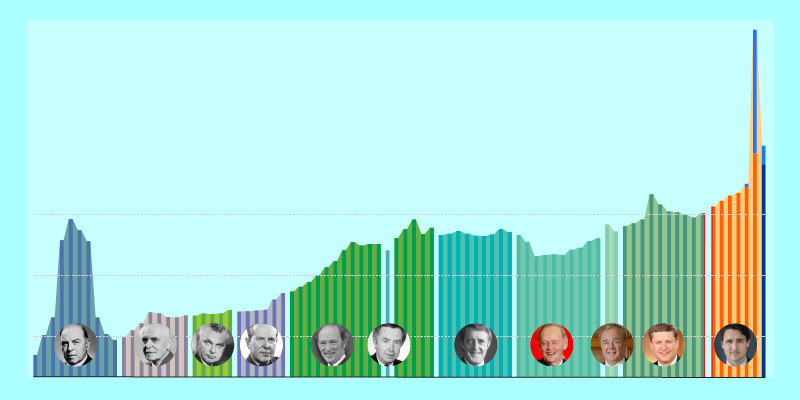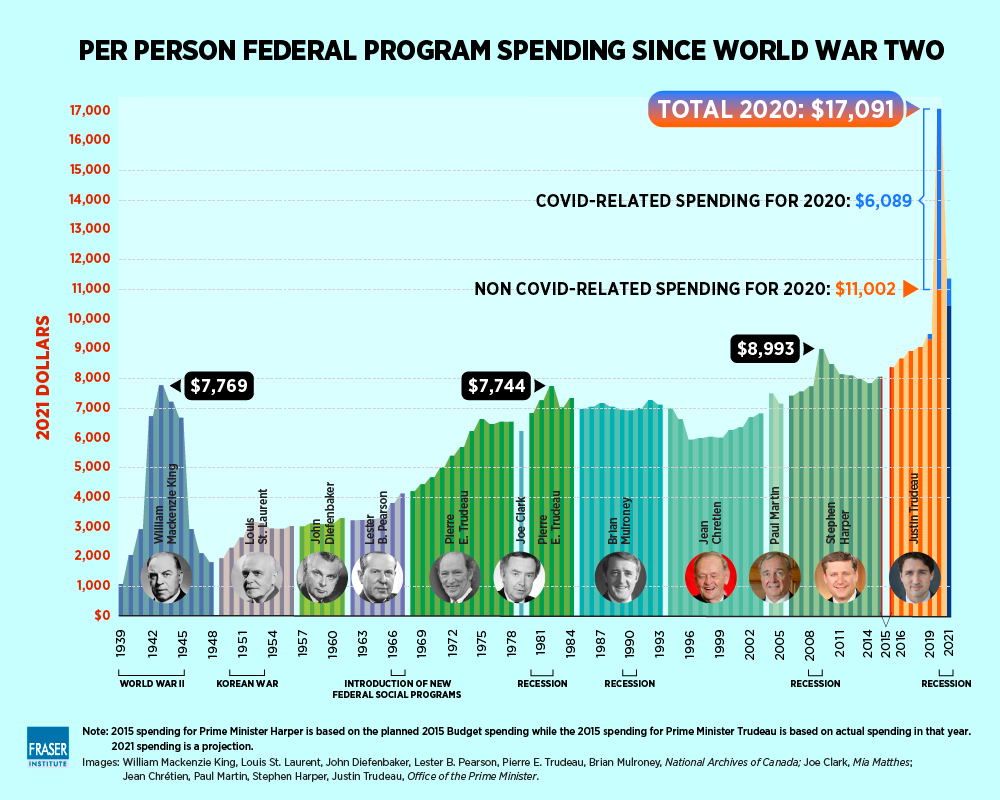Prime Ministers and Government Spending: 2021 Edition

After experimenting with hundreds of billions in new spending initiatives and an array of temporary programs in response to the pandemic, the federal government appears primed to further expand its involvement in the post-COVID economy to “build back better.” However, the size of government in Canada had been increasing well before the pandemic, and based on that experiences, this approach is unlikely to produce its desired results.
There are two primary measures to gauge the size of government. The first is per-person spending. In 2020/21, the federal government spent the largest amount of money per person (adjusted for inflation) in Canadian history by a wide margin. Indeed, per-person program spending will reach a projected $17,091 (in real 2021 dollars), which is approximately double the amount spent during the 2009 recession and at the peak of the Second World War.
But the rapid increase in spending began well before the pandemic. During Prime Minister Stephen Harper’s last year in office, program spending was budgeted to reach $263.2 billion. This meant per-person spending (again, after adjusting for inflation) would be $8,063 in 2015. However, Prime Minister Trudeau immediately increased spending after winning election in late-2015 and has continued this trend every year since.
By 2018, federal per-person spending had grown to $9,061, which was the highest amount in Canadian history up to that point. Per-person spending set a new record again the following year, rising to $9,500. This means the Trudeau government increased real per-person federal government spending by nearly 18 per cent during its first term in office, and before any recession.
Another way to measure the size of government is to compare government spending with the size of the Canadian economy. Research demonstrates that the size of government matters for economic growth. Recent data from Fraser Institute senior fellow Livio Di Matteo, for instance, concludes that economic growth is maximized when government spending is between 24 per cent and 32 per cent of the economy.
Between 2015 and 2019, the Trudeau government increased federal spending (as a share of the economy) from 14.5 per cent to 16.2 per cent. Once we include government spending by the provinces and local municipalities, the International Monetary Fund (IMF) estimates all government spending reached 41.2 per cent of the Canadian economy in 2019—well above the optimal level.
Excessively large government usually entails government becoming active in ways that are counterproductive to economic growth. For instance, by redistributing income from certain groups to others, and favouring certain industries and sectors of the economy through corporate welfare and protectionism, the government will likely help slow economic growth.
For these reasons, increasing the size of government between 2016 and 2019 did not produce better results for the Canadian economy. Instead, the Trudeau government oversaw weak performance for income growth, labour markets and business investment—which are all critical to economic growth and social progress.
Specifically, the average annual growth in GDP per capita (a broad measure of income) was just 0.8 per cent during 2016 to 2019 compared to the 3.7 per cent growth rate experienced during a comparable 1997 to 2000 period under the Chretien government. Moreover, total business investment declined (on average) by 0.2 per cent from 2016 to 2019.
Clearly, larger government is not always associated with improved outcomes. The Trudeau government must consider these negative economic consequences before it cultivates an even greater role for itself in coming years with new programs such as national daycare, national pharmacare and expanded infrastructure. Current projections (which do not include these potential new programs) already indicate federal program spending in 2021 will reach $11,370 per person—or 18.7 per cent of the economy—which is considerably higher than the size of government in 2019, the year before the pandemic.
Expanding federal government involvement in the economy post-COVID will impede prosperity for Canadians and their families and slow our economic growth at a time when growth is sorely needed. That’s not a recipe for success.
Authors:
Subscribe to the Fraser Institute
Get the latest news from the Fraser Institute on the latest research studies, news and events.


